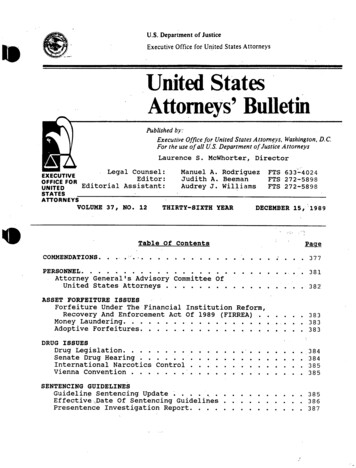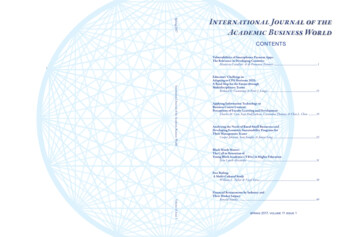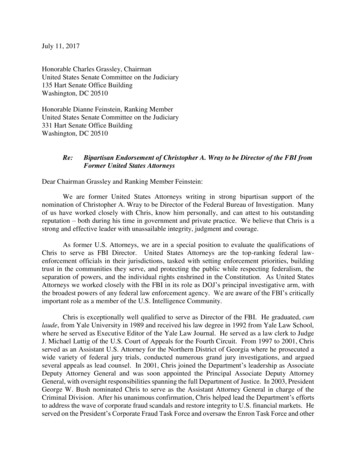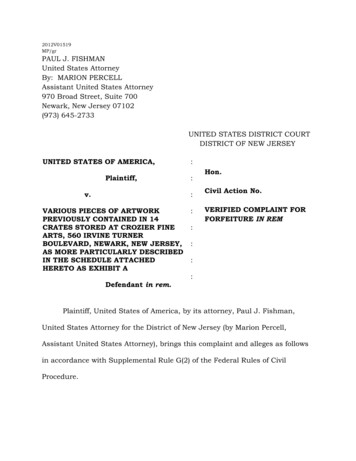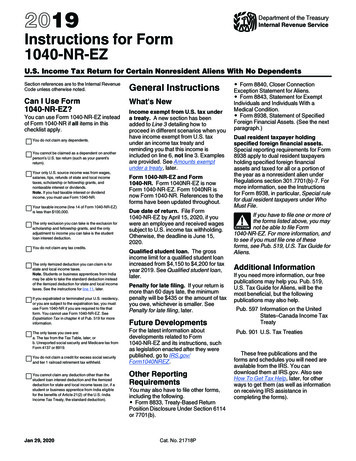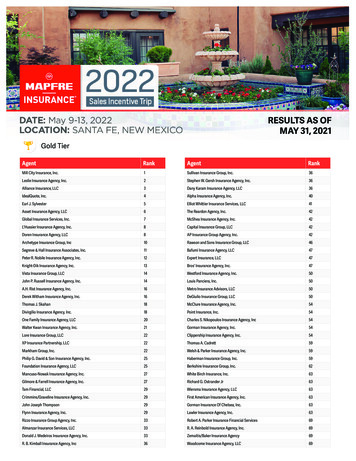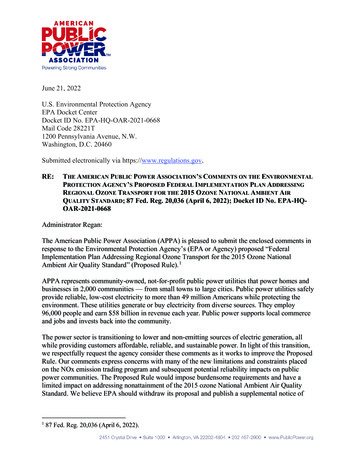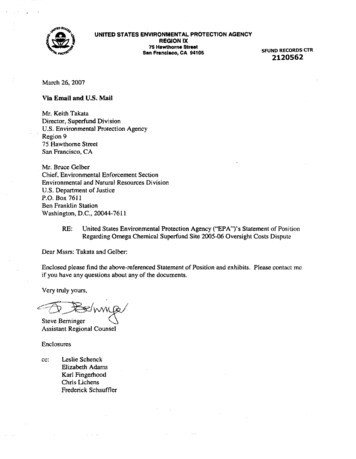
Transcription
UNITED STATES ENVIRONMENTAL PROTECTION AGENCYREGION IX75 Hawthorn* StreetSan Fnmebco, CA 94105SFUNDRECORDS CTR2120562March 26, 2007Via Email and U.S, MailMr. Keith TakataDirector, Superfund DivisionU.S. Environmental Protection AgencyRegion 975 Hawthorne StreetSan Francisco, CAMr. Bruce GelberChief, Environmental Enforcement SectionEnvironmental and Natural Resources DivisionU.S. Department of JusticeP.O. Box 76 11Ben Franklin StationWashington, D.C., 20044-7611RE:United States Environmental Protection Agency ("EPA")'s Statement of PositionRegarding Omega Chemical Superfund Site 2005-06 Oversight Costs DisputeDear Mssrs: Takata and Gelber:Enclosed please find the above-referenced Statement of Position and exhibits. Please contact meif you have any questions about any of the documents.Very truly yours,Steve BemingerAssistant Regional CounselEnclosurescc:Leslie SchenckElizabeth AdamsKarl FingerhoodChris LichensFrederick Schauffler
Case No. 00-12471UNITED STATES OF AMERICA,Plaintiff,Dispute Resolution Pursuant to ConsentDecree Paragraph 57v.ABEX AEROSPACE DIVISION andPNEUMOABEX CORPORATION; AIRPRODUCTS AND CHEMICALS, INC.; ALCOAINC.; ALLIED SIGNAL, INC. (now known asHONEYWELL INTERNATIONAL, INC.);ALPHA THERAPEUTIC CORPORATION;APPLIED MICRO CIRCUITSCORPORATION; APPROPRIATETECHNOLOGIES II. INC.; ARLONADHESIVES & FILM; ARMOR ALLPRODUCTS CORPORATION; AVERYDENNISON CORPORATION; BASFCORPORATION; BAXTER HEALTHCARECORPORATION; BOEING NORTHAMERICA, INC.; BONANZA ALUMINUMCORP.; BORDEN, INC.; BOURNS, INC.;BROADWAY STORES, INC.; CALIFORNIADEPT. OF TRANSPORTATION; CALSONICCLIMATE CONTROL, INC, (now known asCALSONIC NORTH AMERICA, INC.);CANON BUSINESS MACHINES, INC.;INTERNATIONAL PAPER COMPANY;WASTE MANAGEMENT, INC.; UNITEDDOMINION INDUSTRIES; CITY OF LOSANGELES, DEPARTMENT OF AIRPORTS;CITY OF SANTA MARIA; COUNTY OF LOSANGELES; CROSBY & OVERTON, INC.;DATATRON1CS ROMOLAND, INC.;DEUTSCH ENGINEERED CONNECTINGDEVICES/DEUTSCH GAV; DISNEYLANDCENTRAL PLANT; DOW CHEMICALCOMPANY; FHL GROUP; FIRMENICHINCORPORATED; FQRENCO, INC.;GAMBRO, INC.; GATX TERMINALSCORPORATION; GENERAL DYNAMICSCORPORATION; GEORGE INDUSTRIES;GOLDEN WEST REFINING COMPANY;GREAT WESTERN CHEMICAL COMPANY;GSF ENERGY, LLC. (successor to GSFENERGY, INC,); GULFSTREAMAEROSPACE CORPORATION; HEXELCORPORATION; HILTON HOTELSCORPORATION; HITACHI HOMEELECTRONICS (AMERICA), INC,; BPAMERICA, INC.; HONEYWELL-1iUNITED STATES ENVIRONMENTALPROTECTION AGENCY'S STATEMENTOF POSITION REGARDING CERTAINOVERSIGHT COSTS
INTERNATIONAL INC.; HUB8EL INC.; HUCKMANUFACTURING COMPANY (by its formerparent Federal Mogul Corporation); HUGHESSPACE AND COMMUNICATIONSCOMPANY; HUNTINGTON PARK RUBBERSTAMP COMPANY; INTERNATIONALRECTIFIER CORPORATION; JAN-KENSENAMELING COMPANY; JOHNS MANVILLEINTERNATIONAL, INC.; K.C. PHOTOENGRAVING CO.; KESTER SOLDERDIVISION, LITTON SYSTEMS, INC.;KIMBERLY CLARK WORLDWIDE. INC.;KOLMAR LABORATORIES, INC.; LOSANGELES COUNTY METROPOLITANTRANSPORTATION AUTHORITY; LOMALINDA UNIVERSITY; BRITISH ALCANALUMINUM, P.L.C.; MATTEL, INC.;MAXWELL TECHNOLOGIES, INC.; THE MAYDEPARTMENT STORES COMPANY;McDONNEL DOUGLAS CORPORATION, awholly owned subsidiary of the BOEINGCOMPANY; MEDEVA PHARMACEUTICALSCA, INC. (f/k/a MD PHARMACEUTICAL INC.);METROPOLITAN WATER DISTRICT OFSOUTHERN CALIFORNIA; M1CO INC.;MINNESOTA MINING ANDMANUFACTURING COMPANY; QUALITYCARRIERS INC. (f/k/a MONTGOMERY TANKLINES, INC.); Nl INDUSTRIES {a division ofTRIMAS, a wholly 'owned subsidiary ofMASCO TECH); NMB TECHNOLOGIESCORP.iOHLINE CORP.; OJAIMANUFACTURING TECHNOLOGY, INC.;SIEMENS MEDICAL SYSTEMS, INC.;PACIFIC BELL TELEPHONE COMPANY;PACIFIC GAS & ELECTRIC CO.; PIONEERVIDEO MANUFACTURING, INC.; PRINTEDCIRCUITS UNLIMITED; NELLCOR PURTIAN8ENNETT; LONZA INC.; QUESTDIAGNOSTICS CLINICAL LABORATORIES,INC. (f/k/a BIO SCIENCE ENTERPRISES);RATHON CORP. (f/k/a DIVERSEY CORP.);RAYTHEON COMPANY; REGENTS OF THEUNIVERSITY OF CALIFORNIA; REICHHOLDINC.; REMET CORPORATION; RESINARTCORP.; ROBJNSON PREZIOSO INC.;ROGERS CORPORATION; SAFETY-KLEENSYSTEMS, INC. (f/k/a SAFETY-KLEENCORP.); SCRIPTOTOKAI CORPORATION;SHELL OIL COMPANY; THE SHERWINWILLIAMS COMPANY; SIGMA CASTING 2-
CORPORATION (now known as HOWMETALUMINUM CASTING, INC.); SIGNETARMORLJTE, INC.; SOUTHERNCALIFORNIA EDISON CO.; SOUTHERNPACIFIC TRANSPORTATION CO. (nowknown as UNION PACIFIC RAILROADCOMPANY); HARSCO CORPORATION; BMPCOATED STEEL CORP.; TELEDYNEINDUSTRIES INC.; TELEDYNETECHNOLOGIES INCORPORATED;TENSION ENVELOPE CORP.; TEXACO INC.;TEXAS INSTRUMENTS TUCSONCORPORATION (fWa BURR-BROWNCORP.); TITAN CORPORATION; TODDPACIFIC SHIPYARDS; TREASURE CHEST;PACIFIC PRECISION METALS, INC.; UNIONOIL COMPANY OF CALIFORNIA; UNITEDPARCEL SERVICE, INC.; UNIVERSAL CITYSTUDIOS, INC.; VAN WATERS & ROGERSINC.; VOPAK DISTRIBUTION AMERICASCORPORATION (f/k/a UNIVARCORPORATION); VERTEX MICROWAVEPRODUCTS, INC. (f/k/a GAMMA-F CORP.);WALT DISNEY PICTURES ANDTELEVISION; WARNER-LAMBERTCOMPANY; WEBER AIRCRAFT; WESTERNMETAL DECORATING CO.; YORKINTERNATIONAL CORPORATION; YORTINC. (f/k/a TROY LIGHTING, INC.-TIFFANYDIVISION),Defendant. 3-
1IntroductionThe United States Environmental Protection Agency f EPA") hereby submits thisStatement of Position ("Statement") In response to the initiation by the Omega Chemical Site PRPOrganized Group ("OPOG") of formal dispute resolution under the February 28, 2001 PartialConsent Decree ("Partial CD"), pursuant to which studies and work are being performed at theOmega Chemical Superfund Site. This Statement, and the supporting documentation enclosedherewith is filed pursuant to Section XIX of the Partial CD, (The Partial CD (without attachmentsand PRP signature pages) is enclosed as Exhibit t. EPA agrees with OPOG that formal dispute resolution should proceed under Paragraph57 of the Partial CD. Consistent with Paragraph 57, EPA has prepared an administrative record,which will contain al! statements of position, as well as the documentation accompanying thisStatement. The Partial CD provides that, based on the administrative record, the Director of theEPA's Region 9 Superfund Division will issue a final administrative decision resolving the dispute.Partial CD, U 57.b. LBackgroundThe Omega site work is being done as a combination of PRP-lead and fund-lead. OPOGis performing a non time-critical removal action for groundwater, and a soils remedialinvestigation/feasibility study in OU-1, under the Partial CD. EPA is doing most of the OU-2 work,with the exception of installation and sampling of some groundwater monitoring wells, which wasdone by another PRP group. Work related to OU-3 includes an indoor air investigation, and isanother obligation of OPOG under an amendment to the Partial CD.OPOG has disputed all charges billed under the Response Action Contract (RAC) byEPA's contractor, CH2M Hill ("Hill"), claiming that OPOG has inadequate cost documentation onwhich to evaluate: whether the charges are Oversight Costs as defined In the Partial CD;whether the charges are consistent with the National Contingency Plan (NCP); and whetheraccounting errors have been made by Hill.Although the current dispute relates only to costs from fiscal year 2005-06, EPA hasprovided increasingly detailed information to OPOG in support of EPA's requests forreimbursement over the past few years. For the 2001 -02 and 2002-03 oversight cost bids, EPAprovided a financial cost summary and a brief narrative description of the work performed, In fessdetail than the narrative summary portion of the Monthly Status Reports (MSRs) prepared by Hill.OPOG disputed EPA's 2003-04 oversight bit!, requesting additional documentation regardingRAC costs, including Hill's timesheets. In addition to EPA's cost summary, EPA provided the.4.
MSR narrative summaries and EPA's Statement of Work for the Operable Unit One (OU-1) RACwork assignment, detailing further the support Hill provides to EPA for OU-1 activities. Afterreceiving these documents, OPOG paid the 2003-04 bill.OPOG disputed the 2004-05 bill in its entirety (including EPA's costs), for many of thesame reasons as it now disputes the 2005-06 bill. OPOG complained that the MSR narrativesummaries did not provide the appropriate level of documentation to support the contractorcharges, and thar the generality of the work description and the number of persons involved didnot give OPOG enough information as to what was actually done, how much time was spent, andother details necessary to evaluate whether the charges were properly considered OversightCosts under the Partial CD. OPOG again requested Hill's timesheets. OPOG also complainedthat EPA charges were not adequately supported. Alter EPA and OPOG met to discuss the billand resolve the dispute, EPA provided complete MSRs for three months, and offered to provideMSRs for the remaining nine months if OPOG desired,1 After reviewing the complete MSRs,OPOG asked EPA to provide the narrative summary and Report 1 from each MSR for the entirebilling period. EPA complied with this request, and OPOG paid the 2004-05 blli,The present cost dispute arose after EPA sent OPOG a letter on November 28, 2006,requesting payment of the 2005-06 oversight costs, along with EPA's. itemized cost summary,which is the only documentation required by the Partial CD. With that letter, EPA also enclosedthe narrative summary from each MSR for the billing period, in order to facilitate OPQG'spayment of the 2005-06 costs. In that correspondence, and in communications with OPOG sincethen, EPA has maintained its position that it is not required under the Partial CD to provide anyportion of the MSR. {The November 28, 2006 letter and attachments are enclosed as Exhibit 2.)On January 8, 2007, in a letter to Bruce Gelber of the U.S, Department of Justice (DOJ)and Keith Takata of the EPA, OPOG notified EPA that it was disputing Hill's costs because it hadnot received sufficient documentation to support these costs. (Exhibit 3). OPOG requestedsupporting documentation for Hill's work, "in the form of time sheets or other documentationshowing what work was actually done, who did the work, when the work was done, tasksperformed, time spent and hourly rates." This letter also initiated the "informal negotiation period"under the Partial CD (Paragraph 55). During the informal negotiation period, in the interest ofresolving the dispute with OPOG, EPA offered to again provide the Report 1 sections from theMSRs, relating to the 2005-06 costs, in a letter to OPOG's counsel, Leslie Schenck, on January25,2007. (A copy of this letter and attachments Is enclosed herewith as Exhibit 4.) In that letter,1Tha MSRs prepared by Hilt consist of a narrative summary, an itemized "Report 1" ("Work Assignment - Task LevelSpecific Detaii Report"), "Report t A" ("Work Assignment Supplemental Detail Report*), "Report 2T" ("Current MonJh andCumulative Status Report"), "Report 37* ("Variance Based on Extended To-Oate Report"), and Standard Form 1035("Public Voucher for Puretwses and Services Other Than Personal"}.-5-
EPA also provided a sample of a Hill timesheet to demonstrate the nature and type of informationthat can be expected to be included on such timesheets, since it was apparent that OPOG mightbelieve that Hill's electronic timesheets contained detailed descriptions of employee tasks.In its January 25,2007 letter, EPA offered to extend until February 12,2007 the informalnegotiations period, which was due to expire under the Partial CD on January 28,2007. Theparties later extended the informal period until February 26. Subsequently, EPA granted OPOG'srequest to extend the period another week, until March 5,2007. On March 12, OPOG submittedits Statement of Position. {Exhibits).EPA has made several efforts to resolve the current dispute. Communications betweenthe parties include various telephone calls between OPOG's and EPA's counsel, including aconference call on February 5,2007 between OPOG's counsel, Leslie Schenek and KeithMiHhouse and EPA's Steve Berninger, Thanne Cox, and Chris Lichens, as well as KarlFingerhood with the DOJ. On February 6, OPOG asked EPA to provide the details of Hill'squality assurance/quality control process, and EPA's review of Hiti's bills. EPA's emailresponding to OPOG's request on February 12,2007 (and attachment thereto) Is enclosed asExhibits. In response to OPOG's request for them, and in the hope that it would resolve thecurrent dispute, EPA mailed to OPOG the MSB Report 1s for the entire 2005-06 billing period,after OPOG agreed to maintain their confidentiality.2As explained in further detail in this Statement, OPOG is required by the Partial CE) topay oversight costs thereunder, EPA has provided OPOG with even more documentationrelating to the 2005-06 costs than what is required by the Partial CD. In addition to the costsummary EPA customarily encloses with its request for payment of oversight costs, EPA hasprovided OPOG with the narrative summary and Report 1 sections of the MSfls that Hiltprepares. EPA has a process for determining whether Hill charges are adequate, and hasfollowed that process. Moreover, EPA's process comports wilh government contractorrequirements. EPA provided to OPOG ali documents upon which EPA relies. OPOG has askedfor "underlying timesheets . along with the hourly and cost information supporting these bills".OPOG Statement at p.7. This documentation is above and beyond that which EPA typicallyrequires from its contractors. Significantly, the "information supporting*1 Hill's timesheets is notsomething that Is compiled by Hill in its ordinary course of business, or in the case of the 2005-06costs. The burden of providing timesheets outweighs any benefit of providing them. Accordingly,1Because these documents have already been provided to OPOG, and due to their sensitivity, these Report 1s are notbeing enclosed with fois Statement. They wBI be made available under separate cover to the Director ol Jha EPA'sRegion 9 Supertund Division, the administrative decision maker in this matter.-6-
OPOG's assertion that a swift resolution of the dispute can be achieved if EPA provides thetimesheets and other supporting information is inaccurate.EPA's position is strongly supported by case law, which makes it abundantly clear thatadditional cost documentation is not required under the NCP (or under the Partial CD, whichdefines Oversight Costs with reference to the NCP). Innumerable courts have held that EPA, toprove what it spent on an activity, does not have to prove the accuracy of the contractor's costsfor which EPA was billed. Rather, EPA must show only that it tasked the contractor to performresponse (or, in this case, oversight) actions, that EPA received a bill for those actions, and thatEPA paid it. However, in addition to unanimous legal support on this issue, there are alsonumerous practical reasons why EPA should not be required to provide additional information.These legal and practical reasons are discussed at length below.III.EPA is not required to provide mil's tlmesheets or any underlying hourly or costinformation supporting these bills.A.EPA has provided to OPOG cost documentation adequate and sufficient forOPOG to evaluate whether the 2005*06 oversight charges are OversightCosts under the Partial CO, the NCP, and case law, and whether there areaccounting errors that OPOG could challenge.OPOG argues that it cannot evaluate the reasonableness of the oversight charges"without more substantive documentation from Hill, as to the detailed activities each personengaged in, the dates they undertook such activities, the time each activity required, the numberof employees asked to work on each activity and their hourly rate". OPOG Statement at p.10.Before even considering what is required by the Partial CD, NCP and case law, it is noteworthythat, with only one minor exception explained below, OPOG already has the information itrequests.The MSRs contain: iha name of the employee who performed the work in question; themonth in which the specific task was performed; a description of that task; the number of hoursspent on the task by that individual; the hourly rates of the employee; and the dollar amount billedto the task. The only information not communicated by the MSRs is the number of hours anindividual spent on the Omega matter on any particular day within the month in which the chargewas billed.B.OPOG is not entitled to any additional Information (e.g., tlmesheets) underthe Partial Consent Decree between the parties.The Partial CD (Paragraph 44) requires EPA to provide a "Regionally Prepared ItemizedSummary Report which includes direct and indirect costs incurred by EPA and its contractors,-7.
and a DOJ prepared cost summary which reflects costs incurred by DOJ and its contractors, ifany, on a periodic basis." Although this Summary Report is not further defined in the Partial CD,EPA's standard itemized cost summary, in and of itself, constitutes a Regionally PreparedItemized Summary Report. (See Exhibit 21. Of course, as described above, EPA has providedfar more than this cost summary.Tne Partial CD does not require the provision of MSRs or timesheets, and OPOG has notargued that it does. In effect, by demanding timesheets (after EPA provided MSRs in an effort toresolve the dispute), as well as underlying hourly or cost information supporting the timesheets,OPOG is attempting to rewrite the terms of that agreement.EPA strongly disagrees with OPQG's implication that oversight costs have not beenitemized. EPA's cost summary itemizes oversight costs. The MSB narrative summary andReport 1s, provided to resolve this dispute, itemize costs in even more detail. Even a cursoryreview of them demonstrates this. For example, the May 2005 Report 1 contains line item entriestor each of the following: direct labor (professional), direct labor (clerical), other direct costs,travel, computer, equipment, subpool, insurance premium, and indirect costs (including fringe,overhead, and genera) and administrative costs). EPA's cost summary and the MSB sectionsOPOG possesses is more than sufficient for OPOG to determine that oversight costs have beenproperly charged.3C.OPOG is not entitled to any additional Information - i.e., timesheets orunderlying hourly or cost Information - under the NCP or oiise law.OPOG must reimburse the United States for "Oversight Costs" incurred by the UnitedStates in connection with the work done pursuant to the Partial CD "not inconsistent with the[NCP]." Partial CD, H 44. Accordingly, the NCP is directly relevant to what is meant by OversightCosts, and what type of documentation is required to substantiate them. The NCP requires thatEPA:"shall complete and maintain documentation to support all actions taken under theNCP and to form the basis for cost recovery. In general, documentation shall besufficient la provide the source and circumstances of the release, the identity ofresponsible parties, the response action taken, accurate accounting of federal,state, or private party costs incurred for response actions, and impacts andpotential impacts to the public health and welfare and the environment." 40 C.F.R.§ 300.160{a)(1) (2006) (emphasis added).3it is not clear wtiai OPOG means to Imply by describing Itie MSfl as "higWy massaged*. OPOG Statement at p.7. Thenarrative summary portion of the MSR provides Just that - a summary of activities from Ihe then-current and followingmonth.-8-
Courts interpreting the question of consistency of cost documentation with the NCR haveconsistently rejected the notion that any particular document or type of document must beprovided in order for cost documentation to be adequate. Courts have merely required that thedocumentation be "adequate" or "sufficient" to support the cost claim. See, e.g., United States v.W.R. Grace & Co., 280 F. Supp. 2d 1149, 1179-80 (D. Mont. 2003) (affd by United States v.W.R. Grace & Co., 429 F,3d 1224 (9th Cir. 2005)) ("[The NCP] does not establish prescriptivestandards for the content of cost documents"; it "requires only that 'in general1 documentation besufficient to provide an accurate accounting of costs incurred."); United States v. Chrysler Corp.,168 F. Supp. 2d 754, 769 (N,D, Ohio 2001) (holding that NCP "does not contain any specificstandards concerning the documentation of costs"). In Chrysler, the court held that contractor'sinvoices, which broke down expenses into eight general categories such as labor, travel andsubsistence, were sufficiently specific standing alone to meet the requirements of the NCP, inspite of contractor's failure to provide "project daily summaries, project daily details, reimbursabletravel and subsistence logs, contractor personnel reports, equipment usage logs, andsubcontractor reports .,."Ibid.Several courts have examined the need to provide the very type of documentation OPOGseeks. OPOG's attempts to distinguish these cases from the current cost dispute are unjustified.Contrary to OPOG's assertion in its Statement, these cases are directly relevant to the currentdispute. Courts have frequently found cost documentation to be adequate and sufficient, evenwhere there is no indication in the case that timesheets were provided. See, e.g., United Statesv. Ftndett Corp., 220 F.3d 842 (8th Cir. 2000) (upholding summary judgment for EPA on CERCLAresponse costs where "EPA submitted thoroughly detailed cost summaries, supporting data, andother competent evidence to support its claim for recovery of response costs); United States v.Chroma/toy American Corp., 158 F.3d 345, 352 (5th Cir. 1998) (government agencies'documentation of costs was sufficient where it submitted "detailed cost summaries supporting itsoversight expenses"); United States v. Hardage, 982 F.2d 1436 (10th Cir. 1992) (characterizingas "extensive documentation11 affidavits of various EPA and DOJ employees charged withaccumulating the cost data, which "were supported by summaries of cost data accumulated inconnection with the Hardage site, and the source of that data"). In none of these cases was thepresence of timesheets noted by the court.The issue currently before the Director was also considered in a recent California districtcourt case, State v. Neville Chem. Corp., 213 F. Supp. 2d 1134,1139 (C.D. Cal. 2002), in whichthe court specifically held that information identical to that sought by OPOG was not required tobe provided. Neville argued that the timesheets prepared by employees of the CaliforniaDepartment of Toxic Substances Control ("DISC*} failed to provide adequate detail of actual-9-
services performed because project activity codes used to designate DTSC site-related functionswere too general to allow one to determine what specific employee activity was beingdocumented. The court stated:The thrust of Neville's argument is that DTSC's time sheets do not provide aspecific description of exactly what task an employee was engaged in at aparticular time on the Neville site. However, Neville has not cited any casewhere a specific description of exactly what task the employee performed at aparticular time was held to be required by40C.F.R. § 300.160 a)(1).I Emphasisadded. Ibid.A recent unpublished Uniled States District Court opinion (Eastern District of California)also addressed whether EPA provided adequate cost documentation to support EPA'scontractor's response costs. See U.S. v. Atlas Corp., No. CIV F 92-5373 OWW (E.D. Cal. Sept.6,2000). (A copy of this decision has been enclosed as Exhibit 7 herewith.) The courtspecifically addressed the alleged tack of information supporting the charges of Ecology &Environment ("E&E") and E&E's subcontractor. Despite the fact that the supportingdocumentation was limited to three Invoices to prove payment (and no work-performeddocuments were provided by EPA for E&E's subcontractor's bill), the court awarded EPA its fulloutstanding costs. The court based its decision on a declaration from an EPA employee, whostated that E&E does not normally receive supporting documentation for its contractors'subcontractors' work, and on the fact that E&E certified the costs incurred by the subcontractor,Id. at 13. To require the EPA to provide documentation it normally does not require for itself, andwhich is normally kept in the possession of its contractor, E&E, is overly burdensome, and notrequired by the Consent Decree," /of, at 13-14. The court also noted that E&E "certified the costscontained in their bill (including those of the subcontractors) were accurate and were incurred inconnection with the [operable unit]." Id. at 14. This certification is very similar to Hill's certificationof its invoices (see infra discussion, Section III.E),Although OPOG implies that case law does not address contractor oversight costs (asopposed to cost recovery by agencies), it offers no rationale for distinguishing the two. Several olthe cases noted herein would strongly suggest there is no such basis; they specifically addresscontractor costs, as well. See, e.g., United States v, W.R. Grace & Co., 280 F. Supp. 2d 1149,1167 (D. Mont. 2003) (noting that EPA's direct costs at Issue in the case include the cost ofcontractors performing work at the site); United States v. Findett Corp., 220 F.3d 849 (8th Cir.2000) (noting progress reports from contractors was among the cost documentation provided);United States v. Chrysler Corp. 168 F. Supp. 2d 754, 769 (N.D. Ohio 2001) {involvingcontractor's invoices that broke down expenses into eight generai categories);-10-
The oversight costs at issue in this dispute are simply a subset of United States responsecosts, which are to be paid by consensual agreement, rather than as a result of adjudicatedliability. Many courts have considered the question of what documentation suffices to establishthe amount of response costs incurred, both as a general matter of proof and accounting, as wellas with respect to the cost documentation provisions of the NCR. These cases are unanimousthat the cost summaries generated by EPA's accounting system, which are underlain bydocumentation of the project manager's approval of contractor invoices resulting fromperformance of required tasks, demonstrate that response costs were incurred and that EPA paidsuch costs to contractors, without the need to resort to any of the contractor's own documentationof the costs the contractor incurred in performing its contractual obligations.In any event, EPA has done more in the instant dispute, by providing such contractordocumentation. The cost summaries, along with the MSR sections already provided to OPOGare squarely within the type of documentation that is consistent with the NCR, and OPOG has noright to additionaf documentation.0.EPA should not be required to provide the timesheets OPOG requests,because the benefit of providing the timesheets Is greatly outweighed bythe burden upon the agency.1.Hill's timesheets would provide extremely limited information.As noted above, the only additional piece of information that OPOG wil! be able to gleanfrom reviewing Hill's weekly timesheets is the understanding of what particular day a Hitlemployee billed the hours that are already accounted for in both the narrative summary andReport 1 sections of the MSR. (OPOG can already discern the month in which that employeeperformed the work in question.) According to Hill, its employees sometimes make notations ontheir timesheets or elsewhere to assist them in the monthly preparation of the MSR, although thisis neither a required nor customary practice. These notations, because they are incorporated intothe MSR, are already in the information package OPOG possesses.2.Other than timesheets, there is no other time entry Information Hillemployees compile.Hifl does not require its employees to compile any other underlying data pertaining totimesheets in the regular course of business. Hill employees are asked to enter their time Into theelectronic time entry system on a daily basis. When employees are in the field, they may makenotations in a field log or in a separate notebook to ensure accuracy in recording their time.Other employees may decide not to do so; they simpjy enter their time into Hill's electronictimekeeping system. In any event, OPOG's assertion that "EPA could easily and immediately 11 -
resolve this matter by requiring Hill to provide to OPOG the underlying timesheets . along withthe hourly and cost information supporting these bills" is inaccurate. OPOG Statement at p.7.There is no such underlying information gathered by Hill.43.The burden on EPA greatly outweighs the minimal additionalinformation provided by tfmesheets,This Statement may not be the proper forum for EPA to opine on how ;osl-effectiv0 ftwould be for OPOG to annually review all of Hill's timesheets in the hope that OPOG can learnsomething additional related to a Hill employee's work; however, it ts imperative that the burdenupon EPA from providing the timesheets be fully considered. Although OPOG suggests that EPAwould not have to do anything further than require Hill to provide the timesheets, in reality, theagency's statutory responsibilities would necessitate a review of each limesheet to determinewhether there is confidential information that needs to be redacted or that should not be revealedeven under a confidentiality agreement, such as employee's social security number or otherpersonal privacy information.Because EPA does not currently receive or review Hill's individual timesheets, this wouldbe a significant increased burden on the agency's employees' time. An even greater concernwould be that, by providing contractor timesheets or other "underlying" background informationprepared by Hill, a precedent would be set, after which other PRP groups coirtd seek a similarprivilege. EPA coufd be exposed to future cnatenges under existing consent d jcrees, orarguments when negotiating consent decrees, that EPA must make contractor timeshaets orother contractor documents available. For purposes of regional and national consistenc
billing period. EPA complied with this request, and OPOG paid the 2004-05 blli, The present cost dispute arose after EPA sent OPOG a letter on November 28, 2006, requesting payment of the 2005-06 oversight costs, along with EPA's. itemized cost summary, which is the only documentation required by the Partial CD. With that letter, EPA also enclosed




